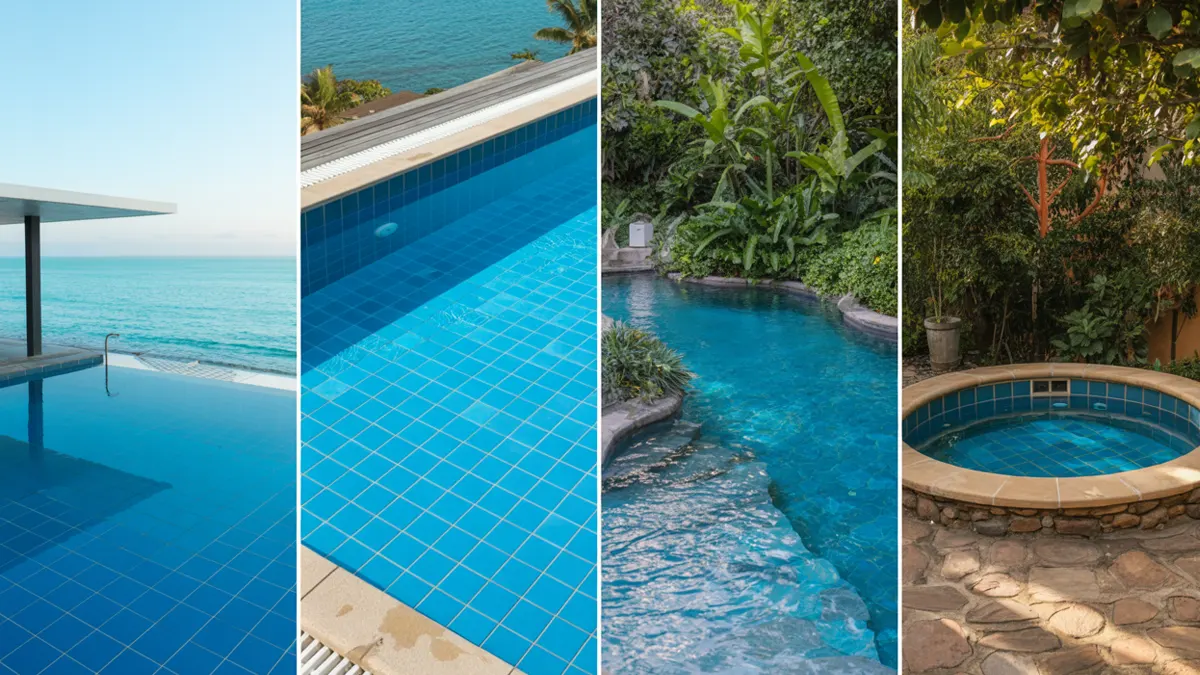
Once summer hits its stride, nothing transforms your backyard quite like a swimming pool. Whether you’re picturing lively weekend gatherings, peaceful evening swims, or simply adding value to your home, choosing the right pool is a big decision.
From sleek infinity designs to eco-friendly natural pools, there’s something for every yard, budget, and lifestyle. To help you make the best choice, we’ve broken down 10 popular types of swimming pools, complete with descriptions, pros, and cons, so you can dive in with confidence.
1. Infinity Pools
Infinity pools are a stunning feat of modern architecture and design. With one or more edges that appear to disappear into the horizon, they create the mesmerizing illusion of water extending endlessly into the surrounding landscape. Often found at luxury resorts, these pools are especially breathtaking when paired with dramatic views.
Pros:
- Visually stunning and luxurious
- Enhances property value and aesthetics
Cons:
- Expensive to design and install
- Requires professional engineering and specific elevation
2. Natural Pools
Natural pools circumvent the use of chlorine and utilize biological filtering and plants instead to purify water. Designed to simulate a pond or fresh swimming hole, natural pools create a serene, natural setting that is in sync with nature. They can have a regeneration zone for filtering that is distinct.
Pros:
- Chemical-free and eco-conscious
- Beautiful, organic design that attracts wildlife
Cons:
- Higher upfront design complexity
- Maintenance of plants and ecosystems can be time-consuming
3. Lap Pools
Lap pools are modern and minimalist—designed for the purpose of doing laps and keeping fit. They’re long and narrow, often rectangular in shape, making them ideal for the fitness enthusiast or small, thin backyard spaces. Lap pools tend to be typically installed in modern homes or indoors.
Pros:
- Great for exercise and physical therapy
- Space-efficient and easy to cover
Cons:
- Not ideal for leisure or family fun
- Design might feel too utilitarian for some homeowners
4. Plunge Pools
These small, in-ground pools are all about short dips and hydrotherapy. Although they’re not designed for swimming laps, plunge pools are great for cooling down or incorporating a water feature into a small urban backyard. They’re also a great option for adding jets and making it a mini spa experience.
Pros:
- Perfect for small spaces and courtyards
- Lower water, energy, and chemical use
Cons:
- Too small for active swimming
- May not accommodate many people at once
5. Spools (Spa + Pool Hybrid)
The “spool” (a combination of spa and pool) is a rapidly growing option for homeowners who desire flexibility in a compact area. Spools are usually around 12–14 feet long and can provide heated water, hydrotherapy jets, and sufficient room for light swimming or relaxation.
Pros:
- Combines relaxation and function
- Compact, stylish, and often usable year-round
Cons:
- More expensive than a basic spa
- Less swimming area than a full pool
6. Above-Ground Pools
If you want something inexpensive and easy to install, go for an above-ground pool. They come in kit or inflatable versions and are particularly favored by families who prefer summer activities without the long-term commitment. Others can be accessorized with decks and fences to make them more attractive.
Pros:
- Affordable and quick to set up
- Ideal for renters or short-term use
Cons:
- Lower visual appeal and less durable
- Can affect property value and resale perception
7. Architectural Pools
These pools are works of art—constructed to replicate the shape, lines, and materials used in your home’s design. With clean lines, angular features, and sometimes custom lighting or waterfalls, architectural pools are as much art as they are function.
Pros:
- Tailored to your home’s design for maximum visual impact
- Often includes high-end materials and finishes
Cons:
- Significant investment in design and construction
- Longer timelines due to customization
Learn More: How Long Does It Take to Build a Pool in Las Vegas?
8. Indoor Pools
Indoor pools are usually constructed within the home or in a specific building, giving year-round swimming regardless of the climate. These are perfect for cold climates, serious swimmers, or homeowners who like privacy and independence from weather.
Pros:
- All-season use and weather-proof
- No outdoor debris or sun exposure to deal with
Cons:
- High cost for construction and ventilation
- Requires substantial indoor space and humidity control
9. Freeform Pools
Consider curves, rocks, waterfalls, and landscaping—freeform pools are designed to be natural looking, such as a lagoon or secret spring. They are highly adaptable and perfect if you are creating a tropical or rural backyard oasis.
Pros:
- Unique, organic shapes allow creative landscaping
- Great for relaxing, lounging, or creating a tropical escape
Cons:
- Irregular shapes may be harder to cover
- Less efficient use of space for swimming laps
10. Zero-Entry Pools (a.k.a. Beach Entry Pools)
Zero-entry pools boast a gradual, sloping entry—similar to a beach—so they’re a favorite among families, elderly, and individuals with mobility impairments. They’re ideal for relaxing at the shallow end and exude that resort-like feeling in the comfort of your own home.
Pros:
- Safe and accessible for all ages
- Offers a true “vacation at home” feel
Cons:
- Requires more square footage due to sloped entry
- More complex design can increase installation cost
Choosing the Right Pool
With all these options, it’s all about your needs: Do you need something rich and beautiful? A playroom for the family? A well-being-focused lap pool? If your priority is function, or form, or fun, there’s a dream pool out there for you.And that’s where Pool R US enters the scene. From initial design consultation through installation and upkeep, Pool R US provides knowledgeable guidance and all-inclusive service customized to fit your budget, yard, and aesthetic.